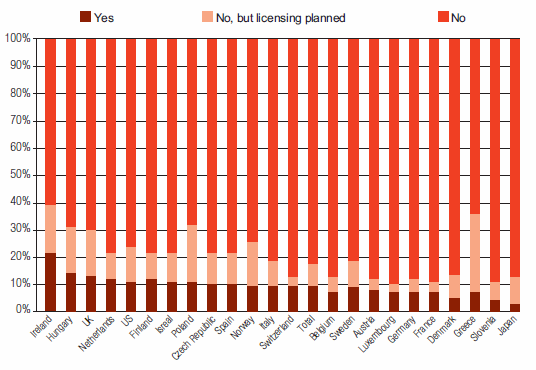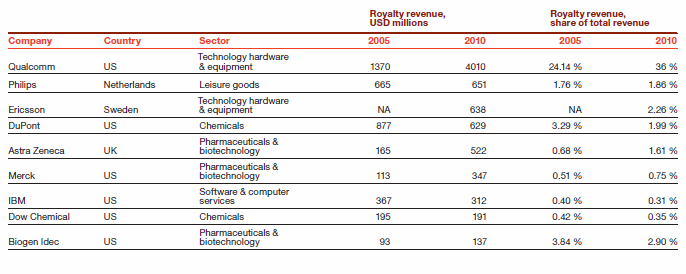
The Evolution of Technology Markets: Separating Fact from Fiction
By Intan Hamdan-Livramento, Economic Officer, Economics and Statistics Division, WIPO
The emergence of open, more collaborative models of innovation has attracted a great deal of discussion in recent years. Open innovation – whereby companies rely less on in-house research and development (R&D) and more on external sources – is often held up as a major change in the innovation landscape. But what evidence is there to support this? This second article in the IP Trends series takes a closer look at the data and reflects on the evolution of technology markets and their role in encouraging more collaborative and open innovation practices. The article draws on the findings of the World Intellectual Property Report: The Changing Face of Innovation published in November 2011.
Markets for Technology
Technology markets play a pivotal role in facilitating open innovation. They provide a framework within which firms can license in inventions that complement and enhance their business objectives. They also make it possible for businesses to generate revenue from licensing out those inventions they are not interested in developing or commercializing.
Collaborative innovation fosters a cross-fertilization of ideas and promotes follow-on innovation. In the smartphone industry, companies source technologies from a range of hardware and software manufacturers to produce a wide offering of consumer products. Apple Inc., for example, complements its own know-how by licensing key technologies from the likes of Qualcomm Inc. and Samsung to make their attractive, high-performance devices.
Companies are increasingly licensing their inventions to generate additional revenue. Surveys indicate that one in every five European companies, one in four Japanese companies and one in seven US companies license out their patented technologies. When the number of companies that would like to license out their inventions is factored in, the share increases significantly (see Figure 1).
Figure 1: The potential to license out patents is far from exhausted

Share of patents licensed out as a percentage of total patents owned by companies in selected high-income countries, 2003-2005
Source: Preliminary findings of Paola Giuri and Salvatore Torrisi (2011) on “The Economic Uses of Patents,”
Final Conference of the InnoS&T project “Innovative S&T indicators for empirical models and policies: Combining patent data and surveys.” in Munich.
________________________________________
In a few cases, licensing is the foundation on which businesses are built. US company, Qualcomm, for example, is in the business of developing groundbreaking technologies that are licensed to external sources. These royalty-bearing licensing agreements generate a sizeable proportion – some 36 percent in 2010 – of the company’s revenue. “The ability to broadly license the technology worldwide to more than 190 suppliers of wireless devices, equipment and related software applications and to earn a reasonable return on investment from licensing the patents is critical to Qualcomm,” notes Donald J. Rosenberg, Qualcomm’s General Counsel.
Specialist firms, that develop their competitive advantage in a specific area and leverage it by licensing out their technologies, form the basis, and encourage the practice, of collaborative innovation. Qualcomm’s Mr. Rosenberg notes, “Qualcomm’s business model – broadly licensing our technology and reinvesting in R&D – is enabling the success of many other companies in the wireless value chain.” He adds “the wide diffusion of Qualcomm’s inventions has generated competition among service providers and device suppliers, enhancing consumer choice and unleashing new economic opportunities for downstream enterprises.”
Intellectual property: the backbone of technology markets
The emergence of markets for technology has been driven by two key factors: increased use of intellectual property (IP) rights and increasing levels of collaboration across firms.
IP rights set intellectual assets up as tradable commodities. A patent, for example, confers the right to exclude others from making, selling or offering for sale the subject matter defined by the claims in a patent document. Those claims, which define the scope of protection, delineate the boundaries of an intellectual asset, making it possible for the patent holder to prevent others from encroaching on the protected technology. These rights are enforceable and transferable. As such, a patented intellectual asset can be sold to a third party for a specified royalty fee. Such transactions are common in open innovation settings.
The patent system also helps drive the market for technology insofar as the disclosure requirement under patent law (an applicant must describe a claimed invention in sufficient detail for a person skilled in the art to carry it out) makes a rich source of technological information freely and widely available. By monitoring published patent information via online databases, such as WIPO’s PATENTSCOPE, a company in the market for a new technology can keep track of key industry developments and identify technologies relevant to its core business. This information can also spark new ideas for innovation, or new applications for existing technologies. Studies reveal that inventors in Japan have been quick to recognize and take advantage of these opportunities. Close monitoring of patent information, also helps safeguard against inadvertently infringing the rights of others.
Striking the right balance
Economists argue that technology markets underperform where the IP system is weak because companies are reluctant to license out their technologies in the face of high IP theft risk. This causes the pool of technologies available for licensing to shrink and inhibits collaborative and follow-on innovation.
A strong IP regime, however, can inflate the cost of purchasing technologies. In settings in which innovation is cumulative and ownership of essential technologies is spread among many right holders, licensees are vulnerable to “royalty stacking” (whereby the cost of developing new inventions increases because of the sum of royalties incurred from negotiating with each patent holder) and risk “hold-up” of their invention (where a patent holder can refuse to license a key technology, or will only do so for a larger royalty payment). This, too, inhibits follow-on innovation.
While striking the right balance for IP protection can be challenging, there is growing evidence that markets for technology, where they exist, facilitate open innovation.
Signs of growth
Revenue generated from technology markets is increasing rapidly. For the period 1990 to 2009, royalties and licensing fees derived from the international sale of intellectual assets grew at an average annual rate of 9.9 percent. In comparison, over the same period, the value generated from global imports of merchandise grew on average at a rate of 6.5 percent per year.
A growing number of countries are participating in technology markets. In 1990, just 62 countries licensed in technologies from other countries; but by 2007, 147 countries were doing so. Similarly, in 1990, 43 countries licensed out their technologies whereas, in 2007, the figure had reached 143 countries.
While almost all the technologies licensed out originate in high-income countries, there are slight changes in the geographical makeup of those buying and selling technologies. Over the last decade, the share of receipts from middle-income countries (such as Brazil, China and India) participating in the worldwide sale and purchase of technologies rose from 1 percent in 1999 to 2 percent in 2009.
While technology markets are evolving, growth remains concentrated in a few notable sectors, namely, biotechnology, electronics, semiconductors and information and communication technologies (ICT). Innovation in these sectors tends to be cumulative (with new innovation building on or using existing patented technologies in new ways), making licensing a prerequisite for follow-on innovation. These sectors are naturally more geared up to participate in technology markets.
Despite signs of growth, the market for technology is still in its infancy. Data, where available, reveal that the number of transactions in knowledge markets remains low. Companies surveyed in selected high-income countries over the period 2003 to 2005 stated their willingness to license out their technologies but said they were unable to do so (see Figure 1). In the United States, of the publicly listed firms that disclose details of licensing revenue, only a handful generated revenue from licensing which typically accounted for between 1 and 3 percent of their total income (see Table 1).
Table 1: Shares and rates of nominal growth for selected companies, 2005 and 2010

Source: WIPO , based on filings at the U.S. Securities and Exchange Commission (SEC). For a more detailed, but older, analysis
see Feng Gu and Baruch Lev (2004). «The Information Content of Royalty Income», Accounting Horizons, 18(1), 1-12.
________________________________________
Barriers to growth
Evidence shows positive growth trends for technology markets and broad interest in participating in them. Why then are technology markets not more prominent? The specific characteristics of intellectual assets and the problems associated with their sale and purchase, offer two possible explanations.
Intellectual assets are highly specialized “goods”. This makes the process of matching buyers with technology owners difficult. Assessing the “fit” of a given technology to a firm’s needs can be challenging. In many cases, the technologies available are not “plug and play” but need to be configured to the specific needs of the licensee. In addition, the licensor may decide to withhold critical know-how that could be of use to the licensee making it more difficult for the buyer to use the technology at its full potential, for strategic reasons.
Moreover, unlike a stock exchange that facilitates the transaction of stocks and shares, there are traditionally few marketplaces that bring buyers and sellers together. This means there are a handful, if any, benchmarks against which to evaluate the market price of similar assets.
New intermediaries
In response to these challenges, a range of new intermediaries is emerging to facilitate technology transactions. These include IP clearinghouses, exchanges, auctions and brokerages. Such new commercial entities provide a range of services including IP management support, IP trading platforms, IP portfolio building and licensing and frameworks for patent sharing, sometimes referred to as defensive patent aggregation.
Limited analysis is available on the size and scope of the actual transactions taking place via these intermediaries. There are indications however, that activity linked to patent auctions is beginning, albeit from low initial levels. Again, more analysis is required to determine the extent to which these new collaborative intermediaries are enabling open innovation.
Watch this space
While transaction levels remain low compared to the trade in goods, technology markets are evolving and showing great potential for growth. If current trends continue, many more firms are likely to enter the technology market - both with a view to acquiring new technologies for further innovation and to generating new streams of revenue by licensing out their own technologies. While it will take some time for technology markets to mature, their ongoing evolution promises to create many new and exciting opportunities for innovation. This, certainly, is a space to watch.
The WIPO Magazine is intended to help broaden public understanding of intellectual property and of WIPO’s work, and is not an official document of WIPO. The designations employed and the presentation of material throughout this publication do not imply the expression of any opinion whatsoever on the part of WIPO concerning the legal status of any country, territory or area or of its authorities, or concerning the delimitation of its frontiers or boundaries. This publication is not intended to reflect the views of the Member States or the WIPO Secretariat. The mention of specific companies or products of manufacturers does not imply that they are endorsed or recommended by WIPO in preference to others of a similar nature that are not mentioned.